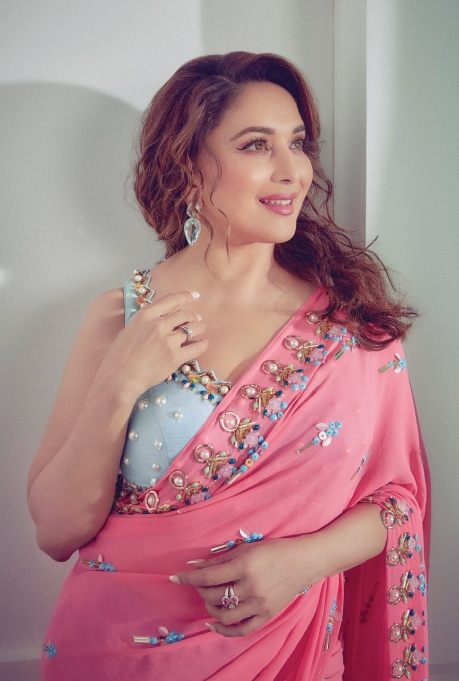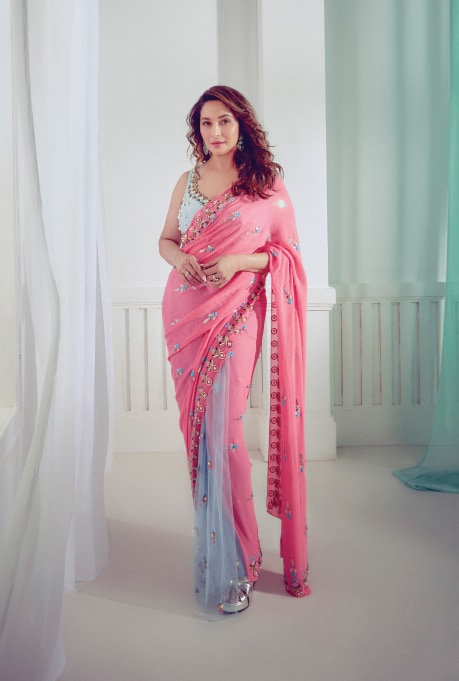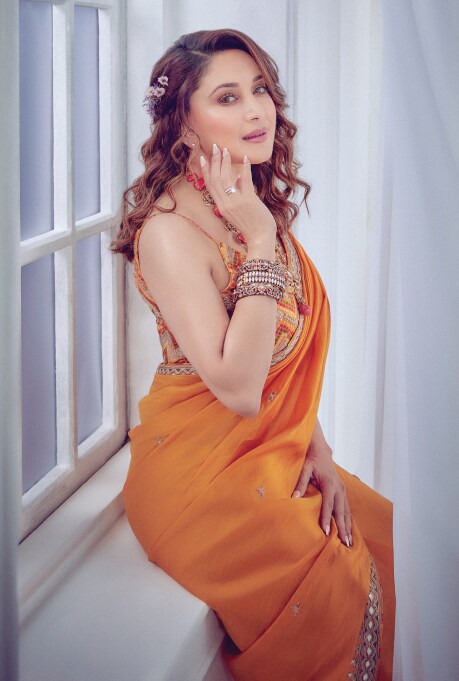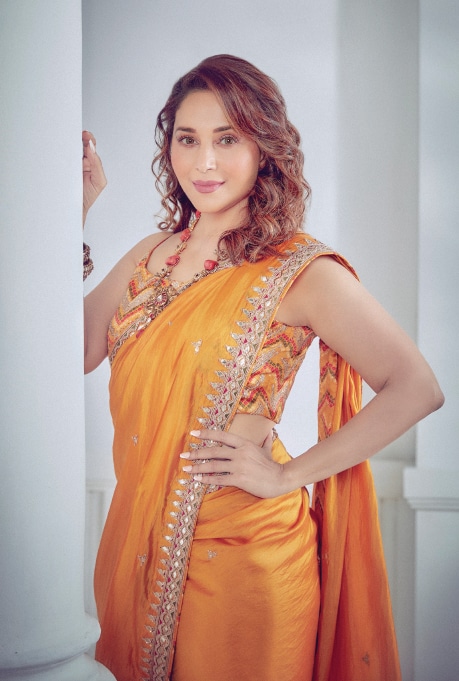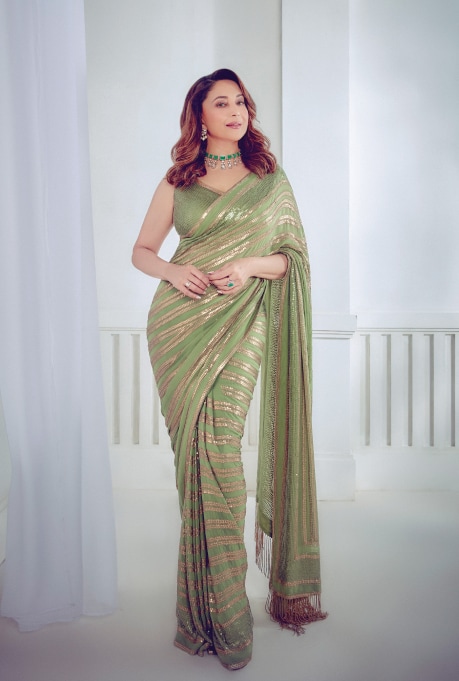The timeless screen icon, Madhuri Dixit has defined stardom in Hindi cinema on her own terms. Here, the diva breaks down some of her style secrets and sari love.
Mohini, Mohini … Anyone who has followed the iconic hits of Hindi cinema would know about this foot-tapping chartbuster from Tezaab, as it introduced the world to the maddening magic that was to be known as Madhuri Dixit. Humko Aajkal Hai Intezaar from the 1990 hit Sailaab to Dhak Dhak Karne Laga, the sensual dance number from the 1992 film Beta, to several iconic hit numbers in Devdas, Dil Toh Pagal Hai, Aaja Nachle and Yeh Jawaani Hai Deewani, the Madhuri wave has been unstoppable.
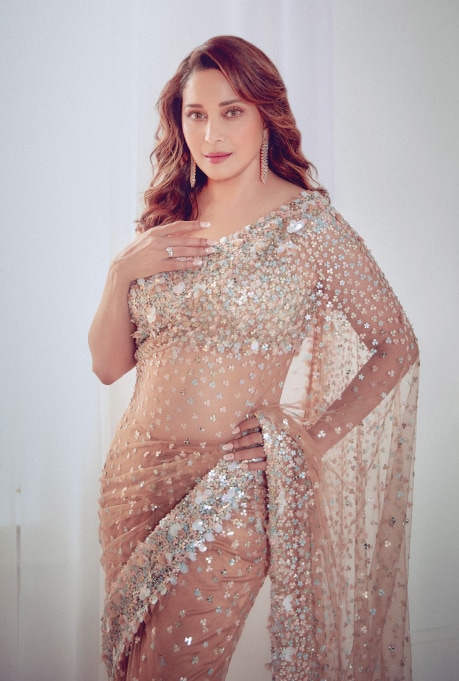
Madhuri reinvented the contours of the feminine Hindi film heroine, combining unbridled sex appeal with authentic acting chops at every move. A female superstar who romanced heroes through decades, fetched awards for her powerful women-centric roles before it became a social media tag, a dancing diva who redefined the metrics of star power, and an ageless beauty who ruled the box-office and hearts for a long time was seen making her OTT debut with Netflix’s The Fame Game in a power-dressing avatar. To celebrate the icon’s Six Yards by Madhuri Dixit, a collaboration with Pernia’s Pop-Up Shop, a curation of saris selected by the star herself, she graces the cover of First Look this season. Read on to discover her eternal style secrets, her enduring love for saris and her fascinating relationship with dance and cinema.
FL: What are some of your favourite style hacks from your The Fame Game wardrobe?
MD: One of my favourite style hacks from the series is the combination of a tank top with a pair of jeans. And Anamika (Khanna) had designed this beautiful white jacket with exquisite motifs in patchwork to go with it. It was an Indo-Western look. There’s a sequence where I go to Tabitha’s (Ayesha Kaduskar) party wearing a business suit. However, Anamika added Indian elements to the ensemble by inserting patchwork of Indian motifs on it. And the result was a very chic look. Another one of my favourites is a skirt, which is more of a lungi skirt featuring a crop top inside. It was a red outfit and marked my introduction in the series. My character (Anamika Anand) is seen wearing that and waving out to the crowd. She is supposed to be a phenomenal actress, so accordingly the outfit featured a stunning trail. I think the kind of embroidery Anamika had done on it, with all finery and the placement of delicate motifs, just added to the stature of the character. It made for such a show-stopping moment.
FL: What style inspires you from Indian cinema of a bygone era?
MD: If you see the songs of Pakeezah, Mughal-E-Azam, everything was designed so beautifully. Think of the gorgeous colour palettes; the green that Meenaji (Kumari) wore for Inhi Logon Ne (Pakeezah) was just beautiful. And the way the artists had created a palette, which acted as an overarching backdrop for her clothes and the set
“For instance, I identify with my character in Sailaab, when she wears a Nauvari (nine yards) sari, also known as Kaashtha, as I’m a Maharashtrian. I’ve seen my mother-in-law and, in fact, women in my family, including my grandmother, wear Nauvari saris, and hence it is very close to my heart.”
MADHURI DIXIT
design, that when I look back at these, I find these looks very inspirational and aspirational. I think Sanjay Leela Bhansali is also inspired by these movies because of the way he creates colour palettes. Especially in Devdas, which is an excellent example of the vividly detailed visuals that we associate with Bhansali’s films. These textures, materials, and colours are simply magical. Then there’s Bhanu Athaiya’s (costume designer) oeuvre of work. The kind of looks she created for Vyjayanthimala for the epic classical dances, or Hemaji (Hema Malini), or even some of the Western looks she created with saris are so beautiful. These aesthetios really inspire me.
FL: Could you tell us about some of your favourite fashion fixes?
MD: I think throws are great simply for the fact that you can just throw them on and achieve a layered look. They add a high-fashion glam quality to your outfit effortlessly. Even if you wear a simple T-shirt and jeans, you can put on a throw, maybe with a bit of ruffles on the edges, and you would be ready to hit the town. Sometimes even shoes can elevate a look. I mean, you can wear something simple and just wear statement shoes to glam up instantly. Even a pair of statement earrings can uplift a look. If you wear a plain chiffon sari with a little bit of prints on it, a nice pair of earrings can offset the look. So, these are some of the fashion fixes you can turn to.
FL: What is your all-time go-to silhouette?
MD: It’s got to be a sari whether it’s a traditional or a chiffon sari, a sari always drapes beautifully and looks good on any body type. Anybody can look good in a sari, it is universal.
FL: You have worn so many iconic saris in your films. Is there a look which is close to your heart?
MD: Sari is integral to India. And the most fascinating part is that every state of India has a different way of draping it. It’s the same six yard, which is worn differently. It could be nine yards as well like the Nauvari sari, which is native to Maharashtra. It’s amazing how India has so many different ways of wearing a single drape. Personally, I connect a lot with some of the looks that I have carried on-screen. For instance, I identify with my character in Sailaab, when she wears a Nauvari (nine yards) sari, also known as Kaashtha, as I’m a Maharashtrian. I’ve seen my mother-in-law and, in fact, women in my family, including my grandmother, wear Nauvari saris, and hence it is very close to my heart.
FL: Why are saris a go-to wardrobe choice for you?
MD: Saris are a go-to for me because they are very elegant. And the kind of saris that you get in India-whether it’s silk, chiffon, Paithanis or Chanderis-they all have a history and a story. A sari not only drapes beautifully, it also looks glamorous as well as elegant at the same time. You don’t even need a lot of jewellery when you wear a gorgeous sari, maybe just a bindi and you are ready to go.
FL: How do you think Bollywood has influenced the culture of wearing saris or Indian wear for that matter?
MD: The Indian diaspora is always connected to their roots. And, I think, that’s the reason why films like Hum Aapke Hain Koun!, Dilwale Dulhania Le Jayenge and Hum Saath-Saath Hain, all these films did so well not only in India but even in overseas markets. When Indians leave the country to live abroad or when second or third-generation Indians grow up there, they still have family back at ‘home’, and have a yearning to revive or keep their roots alive. That’s why they love to wear Indian outfits or simply dress up and celebrate functions like Ganapati puja (Ganesh Chaturthi), Holi and Diwali. Not only in India, but Indian weddings abroad are also elaborate affairs going on for three to four days. So, I think they are always connected with the roots. And with Bollywood’s everlasting and ever-growing influence on everyone, even Americans there know about Bollywood and love to attend Indian weddings because they get to wear the rich Indian costumes. At the end of the day, how you preserve your culture is up to you. Personally speaking, I have a lot of American friends, who love to wear Indian dresses and attend Indian weddings. Whenever I have Ganapati puja at my home, they come over to my house and partake in the celebrations. It’s the same for Holi and Diwali celebrations. I think if you are involved in your own culture you can draw people into it. On the design front, there are a few examples of Indian designers who have made a name for themselves in the international market owing to their signature work involving traditional Indian embroidery and the fact that they impart a quality of Indian-ness to Western outfits. A lot of Western actresses have worn the creations of Indian designers. I think both Bollywood and the Indian fashion industry have a great influence worldwide.
“If you wear a plain chiffon sari with a little bit of prints on it, a nice pair of earrings can offset the look.”
MADHURI DIXIT
FL: Could you decode the creative process or storyboarding of costume designing for films?
MD: Whenever a film wardrobe is done a lot goes into knowing who the character is and what her socio-economic background is as a lot depends on that. Whether she comes from a low-income setting or a rich background like my character Anamika in The Fame Game. Anamika is a big star, so the kind of clothes she wears when she is outside, or when she is at home, are dependent on her star status. So, once we sort of run through all the initial loopholes, the colour story and the style is decided, depending on whether the character is traditional or modern. Of course, my comfort level is also factored in and that’s when I share my inputs, from what colours and patterns I like to what looks good on me etc.
FL: What are your views on the evolution of Bollywood dance? Would you like to tell us about some of the iconic songs and costumes?
MD: I think Bollywood dance has always been an amalgamation of different styles, mixing not only Indian and classical, semi-classical or folk styles but also Western styles. So, it’s always been a melting pot of different dance styles from all over the world. So, when you ask me to pick some of my iconic dances, I would like to say that I was very fortunate to get some really good songs and work with good choreographers like Saroj Khan, Birju Maharaj/i, Prabhu Deva, Ganesh Acharya, Vaibhavi Merchant, and so on. And whenever I worked with them I always strived to give my very best. Once a song grabs people’s imagination, I think what the star wears also becomes iconic. If you see the sari from Didi Tera Devar Deewana (Hum Aapke Hain Koun!), even today if you go to any
“Even today when I judge dance reality shows, I see a lot of people wearing the same costumes that defined the iconic looks of Ek Do Teen (Tezaab) or Choli Ke Peeche Kya Hai (Khalnayak), Ghagra (Yeh Jawani Hai Deewani). Along with the songs and the dances that are iconic, the costumes are also iconic in their own right.”
MADHURI DIXIT
wedding function, you would find a few kids and a few adults wearing the same saris or sporting the same looks. So, that’s how ingrained Bollywood is in our popular culture. Even today when I judge dance reality shows, I see a lot of people wearing the same costumes that defined the iconic looks of Ek Do Teen (Tezaab) or Choli Ke Peeche Kya Hai (Khalnayak), Ghagra (Yeh Jawani Hal Deewani). Along with the songs and the dances that are iconic, the costumes are also iconic in their own right. It has been a great journey, and I have enjoyed every bit of it.

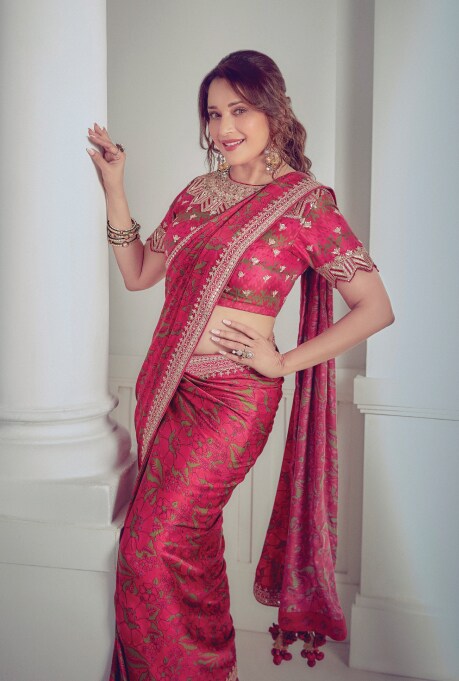
Red Printed Saree – Punit Balana
FL: Is there any particular style from your movies, which you have adopted in real life?
MD: I think all the movies had some style or the other, which I have incorporated in my own life from time to time. I have always felt that fashion goes round in circles. For instance, I remember I had worn a dhoti-sari kind of an ensemble in the film Saajan, for the song Dekha Hai Pehli Baar, and now I see it making a comeback again. Of course, since we live in a different age now, there are more choices available today, and they are also more elegantly showcased today than how they used to be earlier. Amidst all this, saris have stood the test of time as I have always loved them. They are a big part of my wardrobe.
FL: Is there any fashion peeve?
MD: I don’t appreciate frills. I don’t know why people put so many frills-the really big ones-on clothes, although I have myself worn a few frilly stuff. But it is genuinely something that I have always wondered about.
FL: What’s next in store?
MD: I’m excited about the current season (10) of the celebrity dance reality show Jhalak Dikhla Jaa, which is on air now. I will also be seen in a movie for Amazon Prime. The film called Maja Maa is going to be released soon, and I’m looking forward to it.
